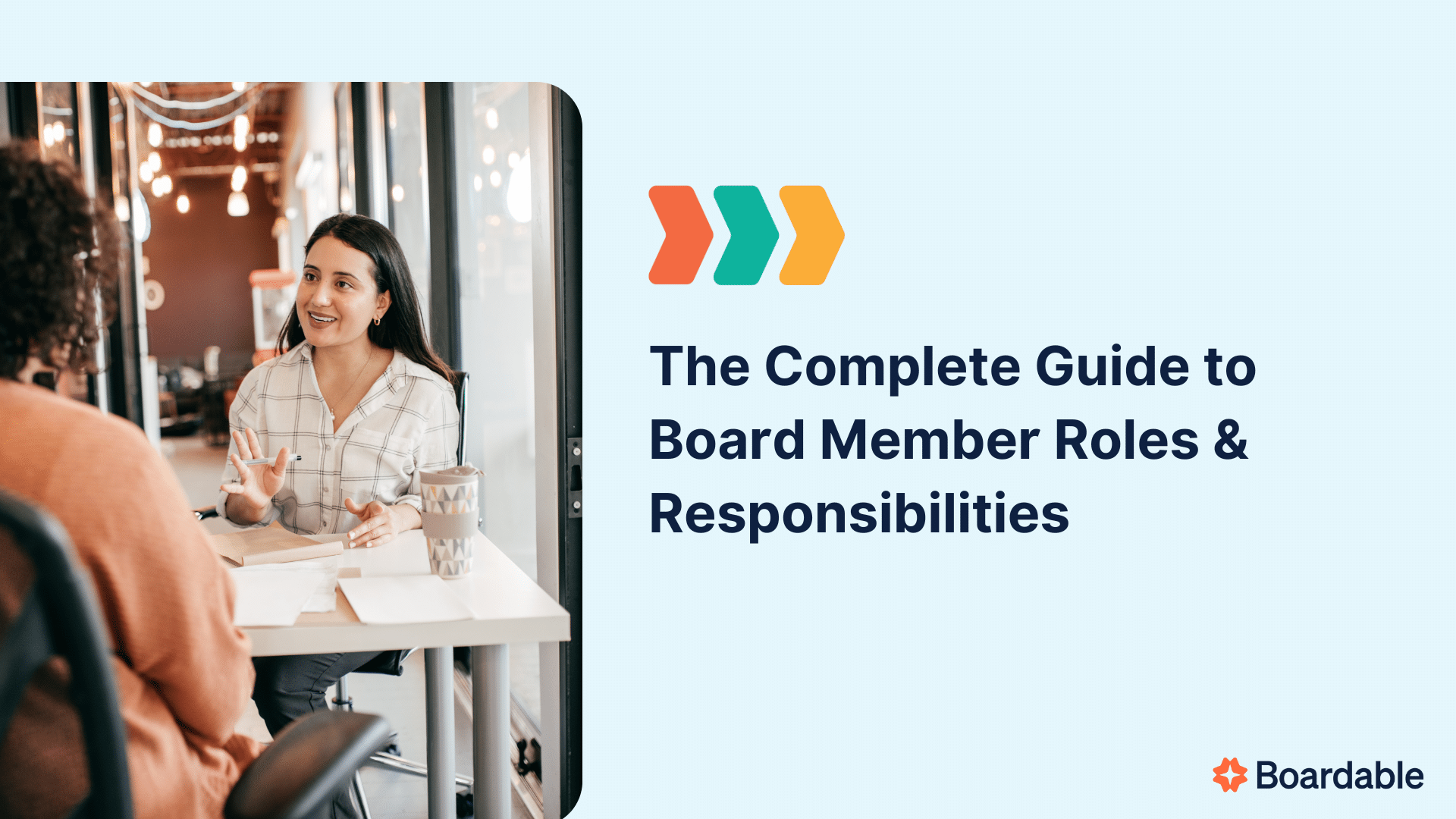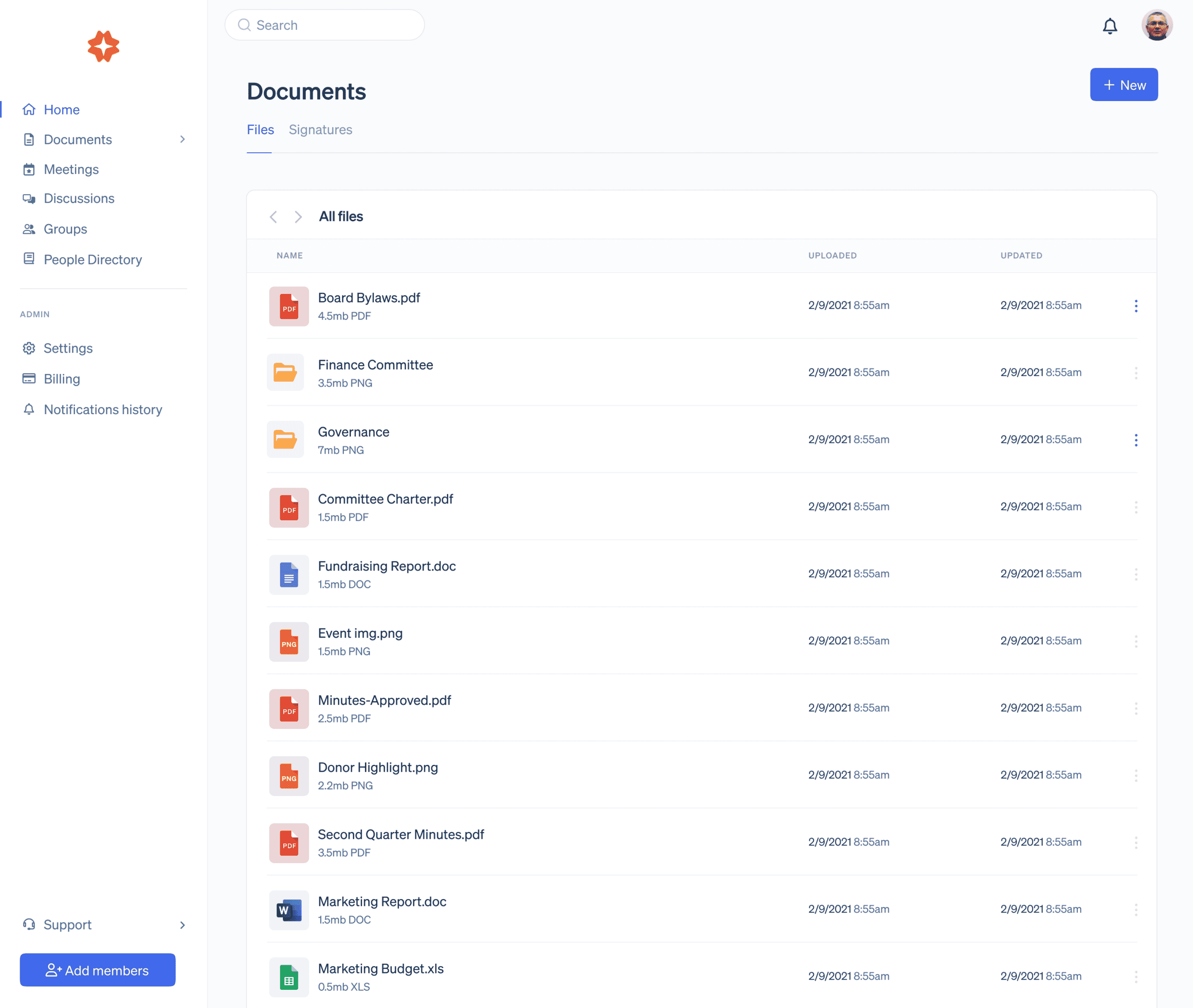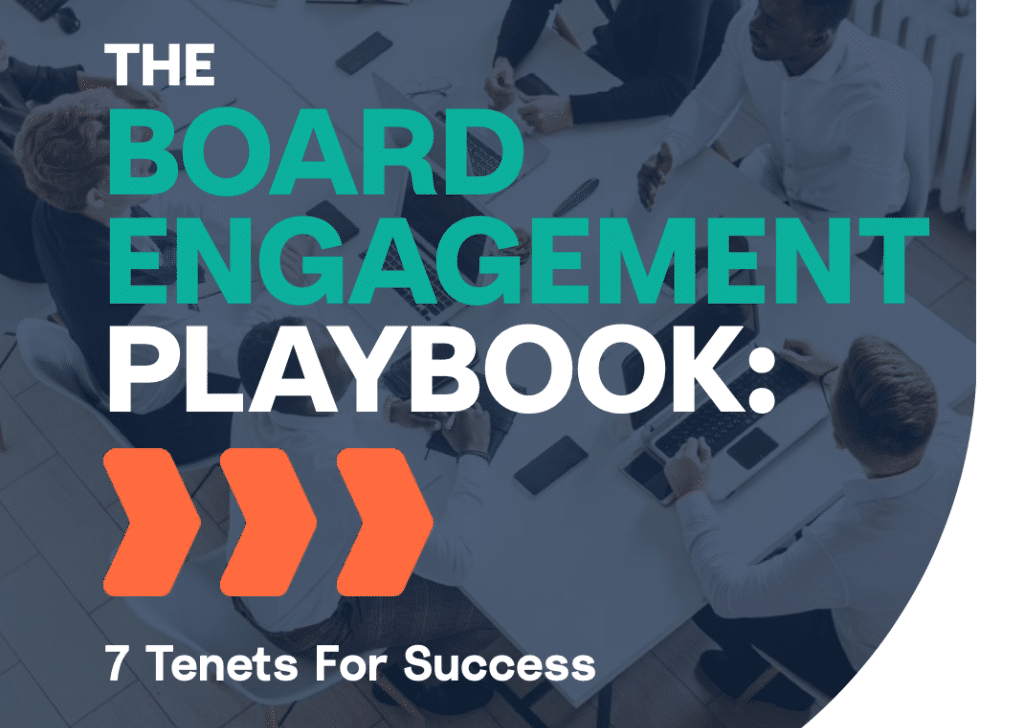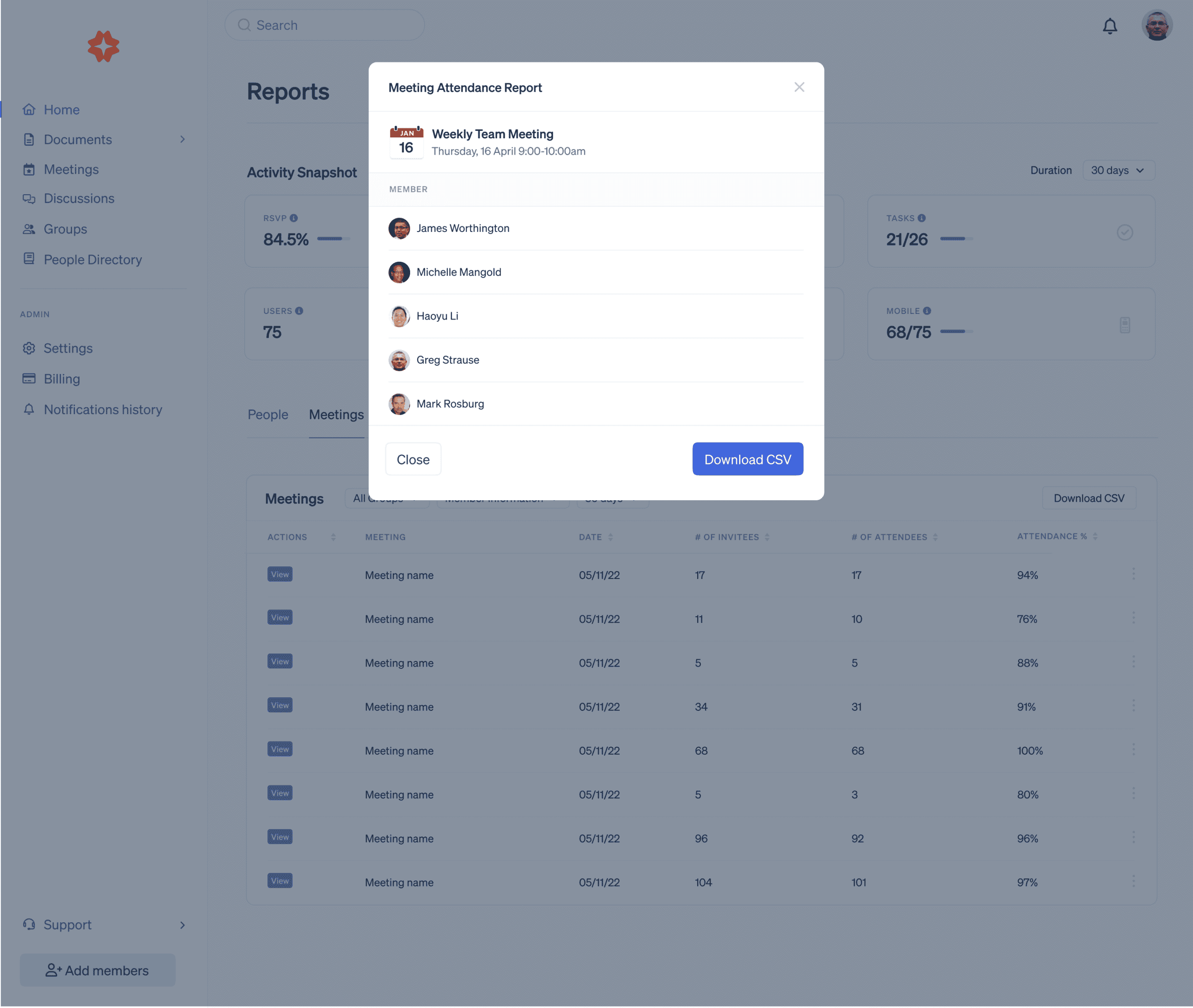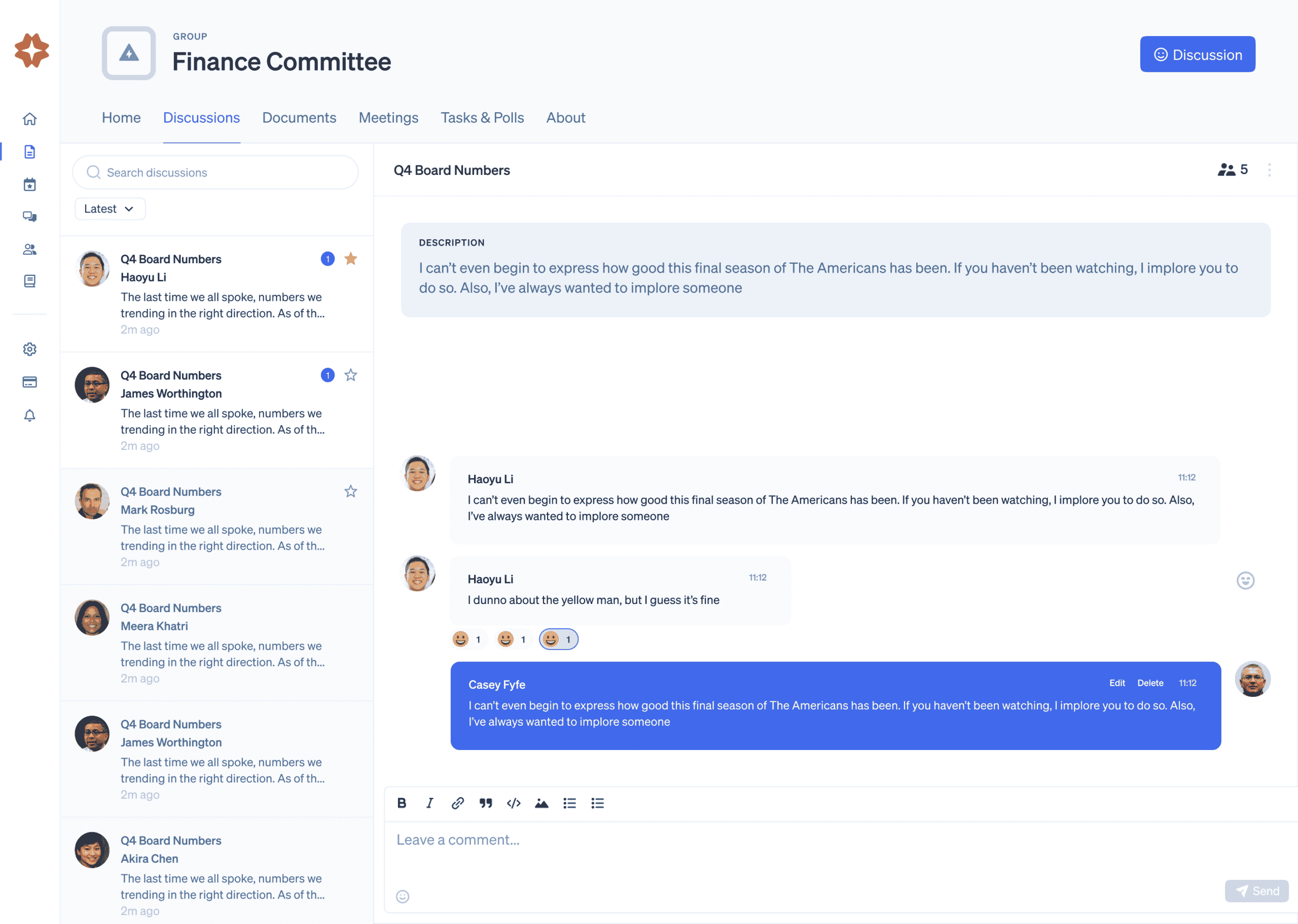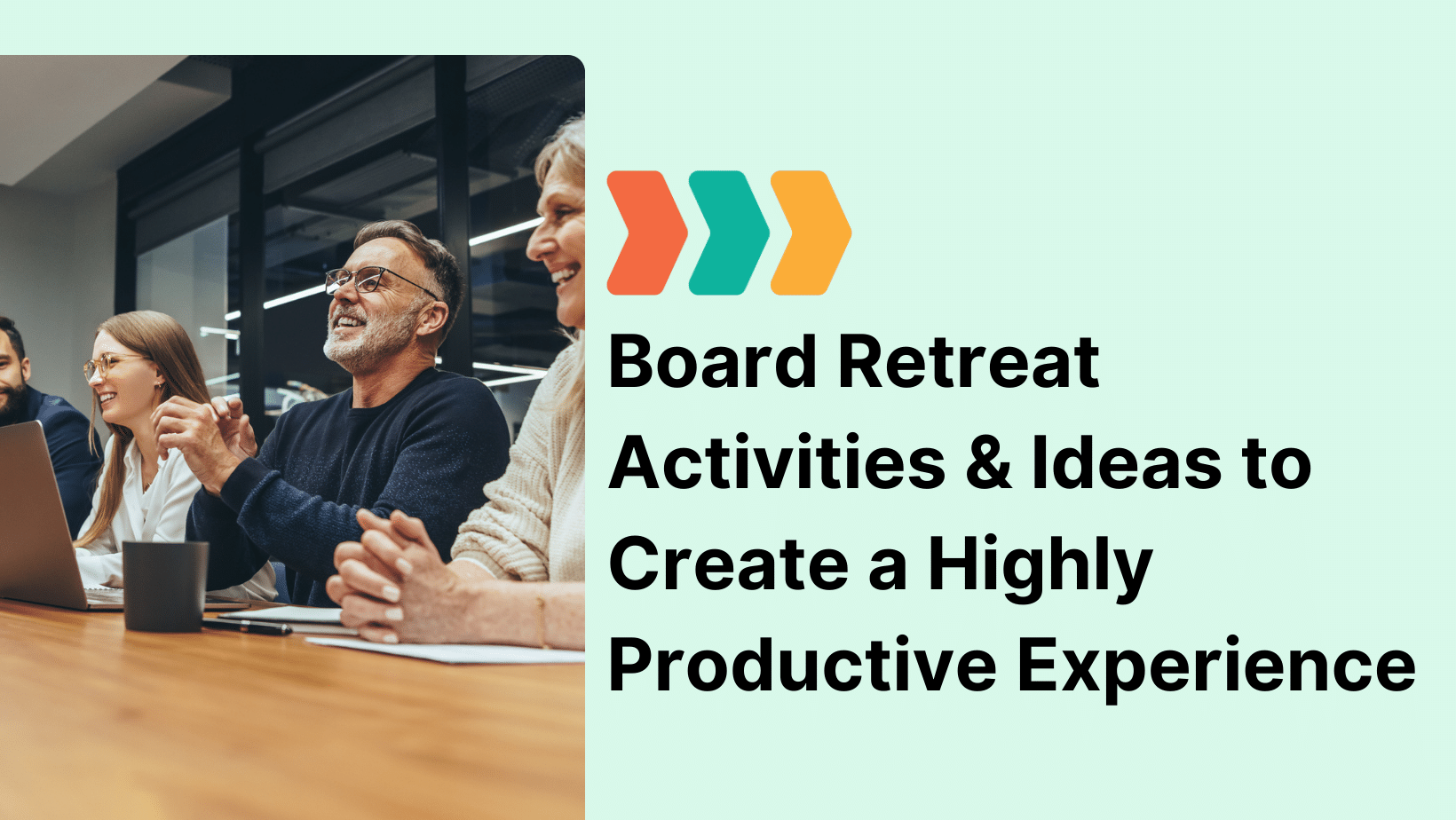One of the most important elements of any organization is having a board of directors or trustees. While the relationship between staff and board can vary widely, every board carries practical, legal, and ethical duties that safeguard oversight and keep the mission on course.
Yet although these core responsibilities remain constant, the governance landscape has evolved: virtual collaboration, AI-powered workflows, and heightened stakeholder scrutiny now set the context for decision-making.
This refreshed 2025 guide combines timeless governance principles with today’s best practices, enabling each director to see exactly where they fit, take confident ownership of their role, and drive the organization’s impact forward.
In this comprehensive guide, we’ll cover everything you need to know about common board member roles and responsibilities, including:
- What Are the Different Board Member Roles?
- The Most Important Board Member Responsibilities
- Basic Board Member Duties
Your board steers your organization toward a sound future by ensuring that it’s fulfilling its mission in the most effective way possible. Setting expectations upfront will lay the groundwork for an effective team that understands exactly what it needs to be doing. Plus, there won’t be any room for excuses when members are called out for not carrying their weight. Let’s dive in.
Board Member Roles: Who Does What?
You’d never apply for a job with no idea of what the role entails. So why ask your board officers to do the same? Before you can start writing guidelines for your board’s leaders, you need to understand those general responsibilities yourself. Let’s explore common board member roles and their corresponding duties.
Board Member Role #1: Chairperson
To function effectively, every group needs a passionate leader. Your chairperson—also commonly referred to as the president—serves as your chief elected officer. As the leader of your board, there are many responsibilities that this individual takes on.
Here are a few duties that are commonly assigned to the chairperson:
- Presides at board meetings
- Creates a purposeful agenda in collaboration with the executive director or CEO
- Appoints people to committees and assigns committee chairs
- Serves as the contact for board issues
- Sets goals and objectives with the board and ensures they are met
- Holds members accountable for attending meetings
- May take on some CEO responsibilities if the organization is comprised of all volunteers
It’s important that this board role is filled by a qualified and passionate individual. Your chairperson should be approachable and an objective listener. They should be a strategist with a deep well of knowledge about your organization. Selecting a well-rounded and respected chairperson will prove invaluable to your team.
Board Member Role #2: Vice-Chair/Chair-Elect
The vice-chair—also commonly referred to as the chair-elect or the vice president—generally offers support for the board chair and other leadership when needed. Think of the vice-chair as the future leader of your organization’s board.
The vice-chair tackles the following duties:
- Prepares to assume the office of the board chair
- Fulfills the board chair’s duties when the presiding officer is absent or if that office becomes vacant
- Assists the board chair in the execution of his or her duties
- Serves on board committees as requested to learn the operations of the board
- Works closely with the board chair to transfer knowledge and history to prepare for leadership
- Leads hybrid-meeting etiquette to keep both in-room and remote voices balanced
Ideally, this board member role will be filled by someone who possesses similar qualifications as the current presiding officer. They’ll be able to step up whenever necessary.
Board Member Role #3: Board Secretary
The role of a board secretary is critical for the smooth operations of the board. Most commonly, this individual ensures that board members are given appropriate notice of meetings and proactively records these meetings. However, their duties extend beyond this and vary from organization to organization.
Some of the day-to-day responsibilities of board secretaries are as follows:
- Assures that an agenda has been prepared by the board president and/or CEO and that the agenda is distributed in advance of the meeting
- Oversees the distribution of background information for agenda items to be discussed
- Leverages AI-generated minutes to accelerate post-meeting follow-up
- Prepares the official minutes of the meeting and records motions, discussions, votes, and decisions
- Prepares and provides the previous meeting’s written minutes to board members before the next meeting and records any changes or corrections
- Assures that documents (bylaws, Form-990, roster of board members) are accessible to members (Pro Tip: Boardable’s Document Center feature is a big help here!)
- Schedules and notifies board members of upcoming meetings
- Keeps members notified of key dates and tasks
A board secretary has to be on top of every task, which also means that this individual needs a fluid set of skills. Some desirable qualities for this position include strong communication skills and the ability to organize and prioritize tasks. This extremely driven and detail-oriented individual should also be well-versed in administrative work.
For a smaller organization, the secretary could be just about anyone who is able to learn quickly and juggle many things. For larger organizations, the secretary is more likely to have a bachelor’s degree and to have served in a secretary position before. Often, this person acts as the executive director’s administrative assistant and prepares board meeting documents, too.
Board Member Role #4: Treasurer
The board treasurer deals with the organization’s finances and makes important decisions regarding spending and investing. This role is a demanding and engaging one, with a lot of responsibility and opportunity to initiate change.
A treasurer typically takes on the following responsibilities:
- Reconciles bank accounts and produces financial statements, which they present at board meetings
- Ensures tax-related documents and legal forms are filed on time, such as the documents required to maintain a nonprofit organization’s tax-exempt status
- Serves as chair of the finance committee and financial officer of the organization
- Manages, with the finance committee, the board’s review of and action on its financial responsibilities
- Assists the chief executive or the chief financial officer in preparing the annual budget and presenting it to the board for approval
- Oversees cybersecurity safeguards for all financial data and payment platforms
- Reviews the annual audit and answers board members’ questions
Usually, a board treasurer should be someone who already has experience in bookkeeping or accounting — but that’s not always necessary. A board treasurer may simply be someone who is highly trustworthy since they’ll be responsible for producing financial statements and handling the organization’s funds.
In larger organizations, the board treasurer may be in charge of staff who will directly manage the organization’s finances. Conversely, in smaller organizations, the board treasurer is more likely to do everything on their own.
Nonprofit Board Member Roles
The very first step is to outline the different types of nonprofit board member roles before writing guidelines. The most common roles include chairperson, vice-chair, board secretary, and treasurer. These roles are necessary to assist with the success of your organization. Once the roles have been established, upload them to Boardable’s document center, where board members can easily find and view them for full transparency.
View Document CenterThe Most Important Board Member Responsibilities
While each leadership position entails its own roles and responsibilities, there are several duties that each and every board member must complete, regardless of their position. As a whole, your board should adhere to the following seven core responsibilities.
1) Board members should advance the mission of the organization
Your board members are among your organization’s most important advocates. These individuals are the face of your cause and should be expected to use their efforts and abilities to promote your organization’s core mission in an ethical manner.
This responsibility will come naturally to your most enthusiastic board members. All directors should proactively promote your work, attempting to ignite that same passion in others. This pertains not only to their personal and professional networks but to public relations as well. When speaking to the media on behalf of your organization, they should paint it in the best light possible.
Overall, spreading awareness for your mission will promote growth and empower your team to flourish in its work.
2) Board members have legal and fiduciary responsibilities
There’s a lot at stake when it comes to managing an organization. Every board of directors needs to understand internal policies and the legal implications of your organization’s activities. Failure to do so can result in severe consequences, such as heavy fees.
It’s up to board members to understand federal, state, and local laws that apply to your specific type of organization. Then, they must assure that the organization adheres to those legal obligations.
For instance, all tax-related filings must be done completely and on time, including all annual state and federal tax returns. In the case of nonprofits, registered 501(c)(3) organizations are exempt from income tax, but they must still pay payroll tax, property taxes, and so on. Failure to file the IRS File-990 return three consecutive times can result in revocation of tax-exempt status. Ensuring that it’s been filed is not only the responsibility of the treasurer but of everyone who participates in fundraising operations.
Additionally, boards should be aware of the penalties caused by:
- Overpaying staff or other individuals
- Engaging in excessive lobbying or political activities
- Making egregious bad bargains on behalf of your organization
Many states also implement laws that require board members to assume fiduciary duties to the served population. This means acting in good faith and working for the benefit of those you serve, never against it.
3) Board members should attend board meetings
According to Bohse.com, the average U.S. nonprofit board meets about 7 times per year. It should go without saying that board members should attend and contribute during meetings, whether they’re gathering virtually or in person. After all, this is when they can share their insight, get creative, and have deep conversations about pursuing greater outcomes for your organization. However, many board members fall short of expectations and become too lax with meetings.
Share the following suggestions to establish a much more collaborative (and much less chaotic) boardroom:
- Review the agenda in advance. Everyone should understand all matters on the agenda heading into the meeting. Participation in discussions is a big part of why you choose someone for a role on the board. Fulfilling these duties is part of acting in good faith for any board member.
- Adhere to the outlined rules of order. For instance, many organizations adopt Robert’s Rules of Order to maintain order in the boardroom. The rules of conduct during meetings are established for a reason and facilitate fruitful conversation. Observing the Rules of Order shows decorum and respect for the organization.
To prevent any issues upfront, consider also implementing an attendance requirement, with exceptions for emergencies and other unavoidable situations. After all, members should have sufficient time to give to your organization. Otherwise, they’re not fulfilling their basic duties.
4) Board members must hire and set compensation for the CEO or Executive Director
Hiring and overseeing the executive director or CEO is one of the most important board member responsibilities as it has the greatest impact on the organization’s growth and vitality. The executive director or CEO serves as the gateway between the organization’s staff and board members.
This responsibility is typically assigned to a few board members who oversee the hiring process. Here are the steps these individuals typical follow when overseeing the executive director of the nonprofit organization:
- Assess the organization’s needs. Determine your organization’s current strengths and weaknesses. This information will serve well in guiding the selection process. The hiring committee will know exactly which skills and qualifications the next executive director or CEO should have.
- Oversee the selection process. Based on the organizational assessment, create a comprehensive job listing, and undergo your search for the most qualified prospects based on the qualifications you set forth. Conduct interviews and narrow down the list. Then, the ultimate decision, including compensation, is up to the entire board.
- Provide support and conduct an annual evaluation. After hiring the new executive director or CEO, your board should make sure they have the resources they need. Then, ensure the individual is fulfilling expectations by conducting an annual evaluation, where you assess both quantitative metrics (measurable data like fundraising goal completions) and qualitative metrics (soft skills like leadership and relationship-building abilities).
Regardless of your mission, this process is a crucial component of any board’s responsibilities. Be sure to select passionate and detailed-oriented board members to serve on your hiring committee, and put a process in place for ensuring ongoing success.
5) Board members are responsible for recruiting new members
Your board members are the most knowledgeable on what skills and qualities are missing from the boardroom. By leveraging this insight, they’re highly qualified to locate the next best board members to fill those gaps.
Current board members should constantly be on the lookout for passionate, qualified recruits who will bring additional knowledge, talent, and background experience to the table. Just like with selecting an executive director or CEO, your board is responsible for locating qualified prospects, conducting interviews, and selecting the most qualified candidates.
RELATED: Check out our complete guide to board member recruitment, where you’ll learn all about locating high-quality candidates and optimizing their experience.
Not only should they participate in recruitment, but current board members should also assist in onboarding new directors. For those who are retiring from their positions, this means training their successors. As for those who are returning for another term, this means proactively getting to know new members, ensuring they have access to the board platform, and simply providing a friendly face in the boardroom.
6) Board members should find digital tools to improve communication
As part of the board’s primary responsibilities, they should make the most of their resources and take the necessary steps to ensure proper governance. This means employing exceptional board software like Boardable to enhance communication and conduct highly-efficient meetings.
A little research will lead to excellent tools that automate almost everything the board does. For instance, Boardable is a one-stop app for all your board management tasks with easy-to-use features like:
- Agenda management: Automate meeting scheduling, develop impactful agendas, take meeting minutes, and conduct polls—all within one convenient platform. This way, you can conduct highly-efficient meetings that engage your fellow board members and provide ample time for strategic discussions. Best of all, Boardable allows your team to see meeting details from any mobile device!
- File sharing: Easily store, organize, and distribute important documents (like financial plans and governing documents). You can even attach documents to specific meetings for quick access during discussions. Plus, Boardable implements privacy features and secure socket layers (SSL) technology, so you know your documents are encrypted and safe.
- Task management: Stay up to date on your responsibilities between board meetings with the Task Manager tool. Each individual user can see their assigned tasks and deadlines, making the next steps scannable in a second. Plus, admins can see everyone’s tasks and hold them accountable.
Implementing the right tools frees your board from distractions, allowing everyone to focus on governance, strategy, and other areas that are vital to your mission. A solution like Boardable comes with standout features (like those mentioned above) to boost efficiency.
7) Board members should serve on at least one committee
Most of the board’s work is completed in committees. There simply isn’t enough time for the entire board to have lengthy conversations and research specific issues in depth. Because of this, every board member should serve on a committee, effectively steering your organization toward its goals.
Individuals should be assigned to committees based on past experience, skills, and interests. For instance, a board member who has a background in accounting would be a great fit for the finance committee.
Like with individual board members, each committee should receive a written document that covers its responsibilities, guidelines, and goals. It’s the full board’s responsibility to regularly assess each committee’s success and adjust accordingly.
Nonprofit Board Member Responsibilities
Based on our experience at Boardable your board should adhere to these seven core responsibilities. These include advancing the mission, fundraising for the organization, attending board meetings, evaluating the CEO, recruiting new members, enhancing board communication, and serving on at least one committee. Our Board Engagement Playbook provides additional resources and guidelines to successfully engage board members.
Download eBookThe Basic Board Member Duties
No matter what your mission is or what expertise your members bring, any board member must fulfill three specific core legal duties. The following duties are adopted across many organizations and should be expected of your board members to maintain your board’s trustworthiness and effectiveness.
1) Duty of Care
Being a board member is more than a résumé builder. Members should be committed to following through on promises and assisting the organization to the best of their abilities. This means:
- Attending meetings and actively participating in committees
- Communicating with the executive director and other board members
- Following through on assignments
- Supporting program initiatives
Board members who neglect this prime duty are simply taking up space in the boardroom. Ideally, your entire board is motivated and truly passionate about your mission. As a result, fulfilling the duty of care is easy.
2) Duty of Loyalty
Board members should do more than show up. They should fully support your work, embody your organization’s mission, and be loyal ambassadors for your cause. When acting on behalf of the organization, each board member must put aside their personal and professional interests.
All activities and decisions should be in the best interest of the organization, not in the best interest of the individual board member.
Those who successfully fulfill this duty are those who proactively mingle with volunteers, visit your organization’s facilities, and participate in community initiatives. These individuals fully embrace your mission, not just board service.
3) Duty of Obedience
One of the more subtle board member duties is obedience. The board should do everything in its power to reach organizational goals, but members still have an obligation to follow your organization’s guidelines. These are found in your governance documents, and every board member has a legal responsibility to understand them.
A board that strays from your governance rules could steer your organization in the wrong direction or even impact your reputation and standing in the community.
As the executive director, CEO, or some other board leader, it’s up to you to provide every new board member with these documents and ensure they obey applicable laws and regulations. You might also encourage existing board members to refresh themselves on your guidelines at least once a year. This ensures they understand exactly what they can (and can’t) do.
Nonprofit Board Member Duties
The basic board member duties can be simplified into three legal responsibilities. This includes duty of care, loyalty, and obedience. These should be expected by your board to maintain their trustworthiness and effectiveness. Use Boardable’s platform data to see which board members are fulfilling these responsibilities and optimize your board’s health.
View ReportingWrapping Up
Enthusiastic board members can breathe new life into any organization. But, that’s only if they first fulfill their basic responsibilities. As a leader of your board, it’s up to you to ensure your fellow board members understand what they should (and shouldn’t) be doing. This way, they can leverage their skills and direct their energy into advancing your organization’s mission in a sound, legal, and ethical manner.
A board of directors does not exist solely to fulfill legal duties, but rather, they contribute to the organization’s culture, strategic focus, and financial sustainability. A well-functioning board that adheres to its responsibilities is essential to the health and sustainability of any organization.
Based on your solidified knowledge of board member roles and responsibilities, you can now confidently move forward with outlining specific duties for your own organization’s board! Just make sure you’re first backed by exceptional board software to streamline communications and carry out vital board processes efficiently.
Request a demo of Boardable to see how AI agendas, e-signatures, and centralized tasks remove friction so board members can focus on impact.
Elevate Your Board Members
At Boardable, we’re with you when you need to do more for your mission. Our connected meeting experience provides more engaging and effective meetings.
